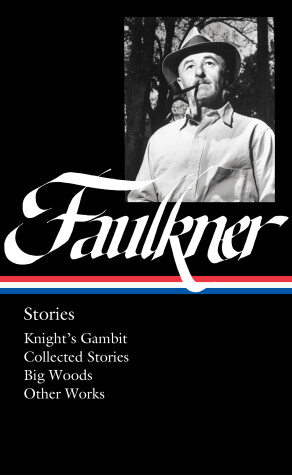LOA
1 primary work
Book 375
Library of America caps its six-volume edition of William Faulkner's works with a volume gathering of all the stories he collected in his lifetime, in corrected texts
Faulkner called the short story “the most demanding form after poetry” and wrote to an editor that “even to a collection of short stories, form, integration, is as important as to a novel—an entity of its own, single, set for one pitch, contrapuntal in integration, toward one end, one finale.” Faulkner was a major practitioner of the short story form and keenly sensitive to its aesthetic demands.
The Library of America edition of the collected writings of William Faulkner culminates with this volume presenting all the stories the author gathered for his book collections, in newly edited and authoritative texts. This is Faulkner as he was meant to be read.
Faulkner’s monumental Collected Stories (1950) presented the author’s first two collections, These Thirteen (1931) and Doctor Martino (1934), along with seventeen new stories, all carefully selected and arranged by the author; Knight’s Gambit (1949) collected six stories about attorney Gavin Stevens’ detective work; and in Big Woods (1955) Faulkner gathered four hunting stories connected with interstitial material. This volume presents these three collections as carefully arranged by Faulkner, with new authoritative and corrected texts that best represent Faulkner’s intentions for the stories. Here are such well-known stories as “A Rose for Emily,” “Barn Burning,” and “A Bear Hunt,” as well as some of his most poetic--“Carcassone”—and less known, such as “The Tall Men,” “Elly,” and “Uncle Willy.”
Also included are Faulkner’s stories “The Hound” (collected in Doctor Martino but omitted by the author from Collected Stories), “Spotted Horses,” Faulkner’s fictionalized autobiographical essay “Mississippi,” as well as his Nobel Prize acceptance speech and helpful explanatory notes by Faulkner scholar Theresa M. Towner.
Faulkner called the short story “the most demanding form after poetry” and wrote to an editor that “even to a collection of short stories, form, integration, is as important as to a novel—an entity of its own, single, set for one pitch, contrapuntal in integration, toward one end, one finale.” Faulkner was a major practitioner of the short story form and keenly sensitive to its aesthetic demands.
The Library of America edition of the collected writings of William Faulkner culminates with this volume presenting all the stories the author gathered for his book collections, in newly edited and authoritative texts. This is Faulkner as he was meant to be read.
Faulkner’s monumental Collected Stories (1950) presented the author’s first two collections, These Thirteen (1931) and Doctor Martino (1934), along with seventeen new stories, all carefully selected and arranged by the author; Knight’s Gambit (1949) collected six stories about attorney Gavin Stevens’ detective work; and in Big Woods (1955) Faulkner gathered four hunting stories connected with interstitial material. This volume presents these three collections as carefully arranged by Faulkner, with new authoritative and corrected texts that best represent Faulkner’s intentions for the stories. Here are such well-known stories as “A Rose for Emily,” “Barn Burning,” and “A Bear Hunt,” as well as some of his most poetic--“Carcassone”—and less known, such as “The Tall Men,” “Elly,” and “Uncle Willy.”
Also included are Faulkner’s stories “The Hound” (collected in Doctor Martino but omitted by the author from Collected Stories), “Spotted Horses,” Faulkner’s fictionalized autobiographical essay “Mississippi,” as well as his Nobel Prize acceptance speech and helpful explanatory notes by Faulkner scholar Theresa M. Towner.
